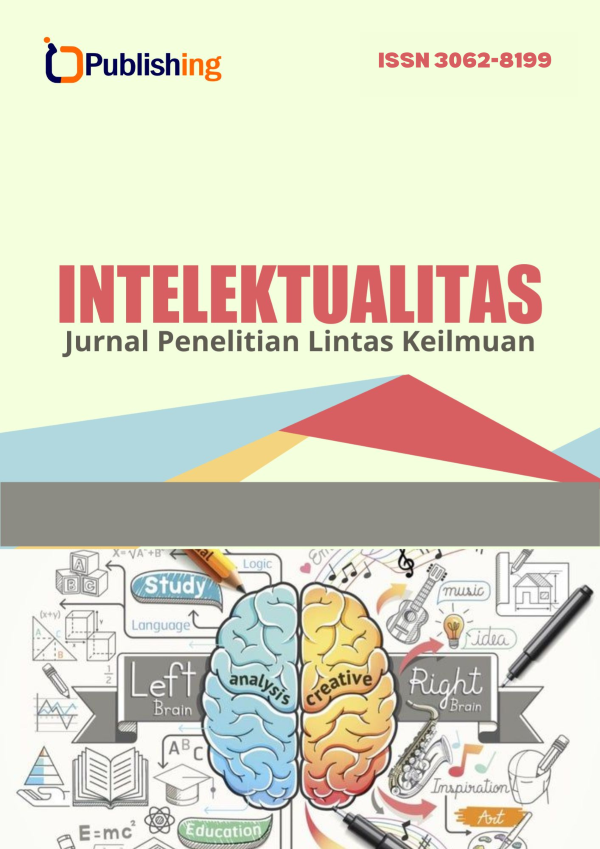Exploring ‘Human’: A Comparative Linguocultural Inquiry across English, Russian, and Uzbek
DOI:
https://doi.org/10.47134/intelektualitas.v1i4.3905Keywords:
Linguocultural Analysis, Concept of Human, Cross-Linguistic Study, English, Rusian, Uzbek, Cultural Worldview, Cognitive Linguistics, Semantic Analysis, Intercultural Communication, Translation StudiesAbstract
Through this investigation, the researchers examine the definition of human in English, Russian, and Uzbek using comparative linguocultural methodology. The fundamental human concept undergoes perceptual modification because of linguistic influence despite its inadequate study across multiple languages. Previous research has studied the concept of humans within individual languages, but there is insufficient systemic analysis between various linguistic traditions. The current investigation utilizes dictionary definitions and corpus-based and discourse analysis to conduct an intercultural examination of humans in English, Russian, along Uzbek. Each language demonstrates universal and specific linguistic features manifest in individualistic agency, followed by collectivist moral responsibility and communal social regulations. Historical, philosophical societal factors thus determine how language expresses humanity. These research findings help advance cognitive linguistics in addition to intercultural communication and translation studies due to evidence showing why translations from direct words lack full cultural contextual meaning. Evaluating these conceptual distinctions helps us understand people from different cultures and improves both communication between them and their mutual understanding. This study shows why combining cultural viewpoints matters for linguistic sciences while providing real-world benefits to translators and diplomats. Future investigations should include more research languages and experimental approaches to enhance our knowledge about language's function as an identity encoder.
References
A. D. Shmelev, Русская языковая картина мира [Russian Linguistic Worldview]. Languages of Slavic Culture, 2002.
A. Mamatov, Til va Madaniyat: Lingvokulturologik Tadqiqotlar [Language and Culture: Linguocultural Studies]. Tashkent State University Press, 2010.
A. Wierzbicka, Semantics: Primes and Universals. Oxford University Press, 1996.
B. L. Whorf, Language, Thought, and Reality: Selected Writings of Benjamin Lee Whorf. MIT Press, 1956.
B. Peeters, Language and Cultural Values: The Ethnolinguistic Dimension. John Benjamins, 2009.
Beltrami, D. (2018). Speech analysis by natural language processing techniques: A possible tool for very early detection of cognitive decline? Frontiers in Aging Neuroscience, 10, ISSN 1663-4365, https://doi.org/10.3389/fnagi.2018.00369
C. Taylor, Sources of the Self: The Making of the Modern Identity. Harvard University Press, 1989.
Corcoran, C.M. (2020). Language as a biomarker for psychosis: A natural language processing approach. Schizophrenia Research, 226, 158-166, ISSN 0920-9964, https://doi.org/10.1016/j.schres.2020.04.032
D. Wilson and D. Sperber, Relevance Theory. Blackwell Publishing, 2004.
E. Sapir, Language: An Introduction to the Study of Speech. Harcourt, Brace & World, 1921.
G. B. Palmer, Toward a Theory of Cultural Linguistics. University of Texas Press, 1996.
G. Lakoff and M. Johnson, Metaphors We Live By. University of Chicago Press, 1980.
J. Holmes, An Introduction to Sociolinguistics. Routledge, 2013.
Kulieva, S.A. (2020). Translingual text within a meaning-generating context of Russian literature. RUDN Journal of Studies in Literature and Journalism, 25(4), 657-670, ISSN 2312-9220, https://doi.org/10.22363/2312-9220-2020-25-4-657-670
Mambetova, G.T. (2023). Comparative analysis of phraseological units with somatism hand as a way of linguocultural competence formation (on the material of Russian, Kazakh, Tuvan and English languages). New Research of Tuva(4), 109-123, ISSN 2079-8482, https://doi.org/10.25178/nit.2023.4.8
Melnyk, N.I. (2021). Representation of ethnicity in lexicographic discourse. Rupkatha Journal on Interdisciplinary Studies in Humanities, 13(1), 1-18, ISSN 0975-2935, https://doi.org/10.21659/RUPKATHA.V13N1.22
Nikitina, T.G. (2021). Modern educational phraseography: Innovative parameters of a paper dictionary. Voprosy Leksikografii(20), 67-90, ISSN 2227-4200, https://doi.org/10.17223/22274200/20/4
Pavlović-šajtinac, M.B. (2024). Linguocultural Elements in Text of Novel “On the Eve” and Analysis of Their Translated Equivalents in Serbian. Nauchnyi Dialog, 13(1), 45-62, ISSN 2225-756X, https://doi.org/10.24224/2227-1295-2024-13-1-45-62
Pivovar, E.S. (2022). Cultural dictionary as a special lexicographic genre. Zanry Reci, 17(2), 108-114, ISSN 2311-0740, https://doi.org/10.18500/2311-0740-2022-17-2-34-108-114
Pulvermüller, F. (2018). Neural reuse of action perception circuits for language, concepts and communication. Progress in Neurobiology, 160, 1-44, ISSN 0301-0082, https://doi.org/10.1016/j.pneurobio.2017.07.001
S. Zhabotynska, Conceptual Worldviews in Different Linguistic Traditions. Cambridge Scholars Publishing, 2009.
Sodel, O.S. (2023). COMPREHENSIVE METHODOLOGY FOR TRANSLATION ANALYSIS OF CROSS-CULTURAL INCONGRUITY IN ENGLISH ANECDOTES. Visnyk Universitetu Imeni Alfreda Nobelya. Seriya: Filologichni Nauki, 2(26), 261-273, ISSN 2523-4463, https://doi.org/10.32342/2523-4463-2023-2-26/1-19
V. Apresjan, Systematic Lexicography. Oxford University Press, 2000.
V. Evans and M. Green, Cognitive Linguistics: An Introduction. Edinburgh University Press, 2006.
Verkhovykh, L.N. (2021). Linguocultural work on the lessons Russian and Russian as a native language as a means to promote learners' cognitive activity. Russian Language at School, 82(4), 21-30, ISSN 2619-0966, https://doi.org/10.30515/0131-6141-2021-82-4-21-30
Vukovic, N. (2017). Primary motor cortex functionally contributes to language comprehension: An online rTMS study. Neuropsychologia, 96, 222-229, ISSN 0028-3932, https://doi.org/10.1016/j.neuropsychologia.2017.01.025
Williamson, J.R. (2016). Detecting depression using vocal, facial and semantic communication cues. AVEC 2016 - Proceedings of the 6th International Workshop on Audio/Visual Emotion Challenge, co-located with ACM Multimedia 2016, 11-18, https://doi.org/10.1145/2988257.2988263
Z. Kövecses, Metaphor in Culture: Universality and Variation. Cambridge University Press, 2005.











